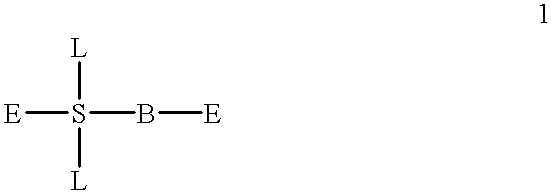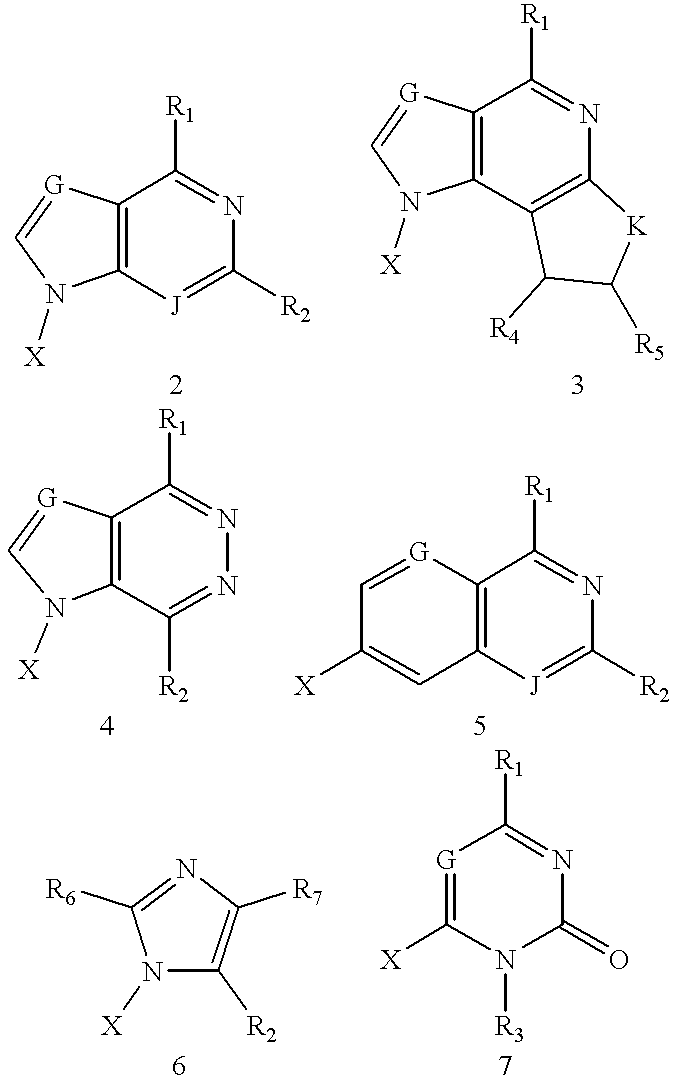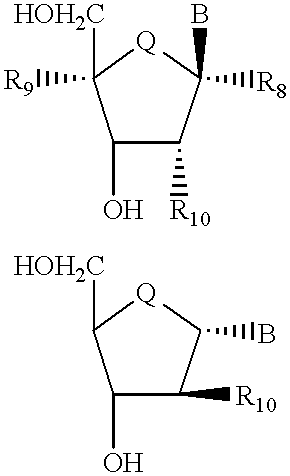Compound for detecting and modulating RNA activity and gene expression
a technology of applied in the field of compound for detecting and modulating rna activity and gene expression, can solve the problems of insufficient activity of antisense oligonucleotide presently available, insufficient generalized antisense oligonucleotide therapeutic or diagnostic scheme, and ineffective therapeutic, research reagent, diagnostic use in any practical sense, to achieve tight binding
- Summary
- Abstract
- Description
- Claims
- Application Information
AI Technical Summary
Benefits of technology
Problems solved by technology
Method used
Image
Examples
example 1
2'-0-(nonyl) adenosine (1)
To a solution of 10 g of adenosine in 400 ml of dimethyl formamide is added 2.25 g of 60% sodium hydride (oil). After one hour, 8.5 ml of 1-bromo-nonane is added. The reaction is stirred for 16 hours. Ice is added and the solution evaporated in vacuo. Water and ethyl acetate are added. The organic phase is separated, dried, and evaporated in vacuo to give a white solid, which is recrystallized from ethanol to yield 4.8 g of the title compound, M.P. 143-144.degree. C. analysis for: C.sub.19 H.sub.31 N.sub.5 O.sub.4. Calculated: C, 57.99; H, 7.94; N, 1779. Found: C, 58.13; H, 7.93; N, 17.83.
example 2
2'-0-(nonyl)-N.sup.6 -enzoyladenosine (2)
2'-0-(nonyl)adenosine (1) is treated with benzoyl chloride in a manner similar to the procedure of B. L. Gaffney and R. A. Jones, Tetrahedron Lett., Vol. 23, p. 2257 (1982). After chromatography on silica gel (ethyl acetate-methanol), the title compound was obtained. Analysis for: C.sub.26 H.sub.35 N.sub.5 O.sub.5. Calculated: C, 62.75; H, 7.09; N, 17.07. Found: C, 62.73; H, 14.07; N, 13.87.
example 3
2'-0-(nonyl)-5'-0-dimethoxytrityl-N.sup.6 -benzoyladenosine (3)
To a solution of 4.0 g of 2'-0-(nonyl) N.sup.6 -benzoyladenosine (2) in 250 ml of pyridine is added 3.3 g of 4,4'-dimethoxy-trityl chloride. The reaction is stirred for 16 hours. The reaction is added to ice / water / ethyl acetate, the organic layer is separated, dried, and concentrated in vacuo to a gum. 5.8 g of the title compound was obtained after chromatography on silica gel (ethyl acetate-methanol triethylamine). Analysis for: C.sub.47 H.sub.53 N.sub.5 O.sub.7. Calculated: C, 70.56; H, 6.68; N, 8.75. Found: C, 70.26; H, 6.70; N, 8.71.
PUM
| Property | Measurement | Unit |
|---|---|---|
| ionic strength | aaaaa | aaaaa |
| ionic strength | aaaaa | aaaaa |
| ionic strength | aaaaa | aaaaa |
Abstract
Description
Claims
Application Information
 Login to View More
Login to View More - R&D
- Intellectual Property
- Life Sciences
- Materials
- Tech Scout
- Unparalleled Data Quality
- Higher Quality Content
- 60% Fewer Hallucinations
Browse by: Latest US Patents, China's latest patents, Technical Efficacy Thesaurus, Application Domain, Technology Topic, Popular Technical Reports.
© 2025 PatSnap. All rights reserved.Legal|Privacy policy|Modern Slavery Act Transparency Statement|Sitemap|About US| Contact US: help@patsnap.com



